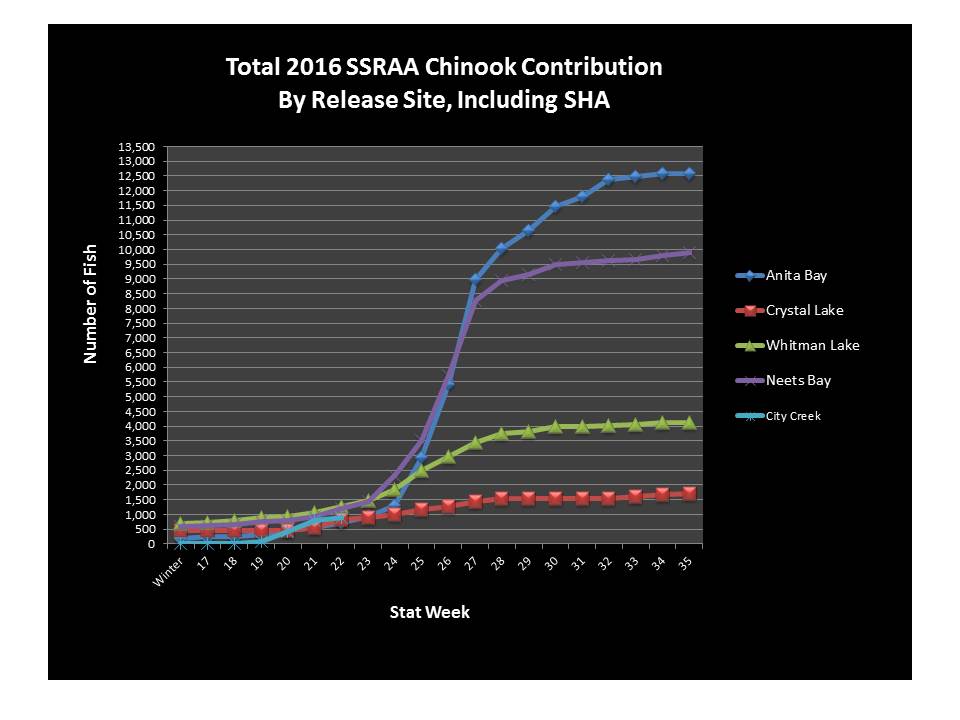06 Sep 2016 Chinook Harvest Update
7 September, 2016 Chinook Return Summary:
Chinook survival/return from SE sources was not good in 2016. The adult return to almost every index stream was below the escapement level and enhanced stocks generally did not do well. For whatever reason, and there isn’t a silver bullet involved, the SSRAA returns were close to what we normally see; though the performance of different releases varied as did the traditional harvest pattern among the gear groups.
Historically the Anita Bay release has not survived as well as releases from Whitman Lake or Neets Bay. This has changed in the past several years. Currently the Anita Bay release is surviving better than the other releases and the Whitman Lake fish have dropped below the other two groups. Crystal Lake: in addition to the fish released at Crystal Lake, some fish reared in freshwater at Crystal are transported to Neets Bay and all the Anita fish are now reared in freshwater there. Currently these fish are doing better than the fish from Whitman Lake and released at Whitman Lake and Neets Bay. Historically survival varies between the sites and there is generally no identifiable reason this…it is simply what is happening at the moment. One thing, since the winters have been warmer for the last 5 or so years, the fish can be reared to a larger size at Crystal than they were during the most recent period of cold winters when the survival of these fish was poor.
Among the three primary release sites, Anita Bay fish are most often caught by net gear while Neets and Whitman fish are more often caught by troll, except in the terminal SHA at Neets Bay, where seiners usually predominate. The increase in Anita survival has moved more of the chinook harvest to the drift fishery and away from Seiners, who are generally more successful in the Neets Bay SHA. This trend has been going on for the past three years, and undoubtedly at some point the trend will go back the other way.
In short, though slightly less, the return was close to average in the context of the past 10 years. The relative survival of Anita Bay and Crystal Lake releases is increasing while Neets Bay and Whitman have dropped a little. These changes are well within the normal variation between the groups.
Please refer to the attached graphics for specific numbers and relative abundances.



10 June 2016 Chinook Harvest Update:
We don’t often try to assess the chinook return until the first of July. While much of the annual harvest has taken place by that time, the data from terminal net fisheries has not been generally available before then. While there is always information about the troll harvest, the troll fishery is not a good annual standard assessment tool. Troll harvest can vary annually by: chinook abundance, opportunity provided by management, effort related to weather and area, price, the cap on spring fisheries, and even politics related to the current situation with the US/Canada Pacific Salmon Treaty. Essentially, every spring troll fishery is a one-of-a-kind opportunity. This spring is no different. A primary factor has been the scarcity of opportunity in the Ketchikan area, because of the relative abundances of Alaska hatchery and treaty chinook; not a high enough percentage of Alaska hatchery fish. That has just changed, but the effect isn’t in the data as yet.
So, regardless of the uncertainty in trying to compare years…we’ll go out on a limb and say this year’s chinook return is good, falling in line with the past several years. Troll harvest, through stat week 23, despite the constraints mentioned above, is in line with the past several years. The largest harvest weeks are the next three, stat week 24 through 26, which will cap the troll harvest and bring the terminal net harvest into the dataset.
We have very little hard information from our program. A handful of fish have already entered the raceways at Whitman Lake. This is early. It doesn’t mean the run is early, at this point it only means some fish have come back early. But, it is not a bad sign going forward. This means there should be some chinook in the Neets Bay SHA and they should soon be showing in the Anita Bay SHA. We will present the terminal harvest information as soon as that is available from ADF&G.
The Neets Bay release is most often the largest contributor to the troll fishery. It looks as if that will prove true this year. The Anita Bay release has shown the best survival the past several years, but these fish go more to the net fleets and won’t show as quickly on the attached graphics.
We’ll try to update this information weekly, as we are able – when we receive new information.


